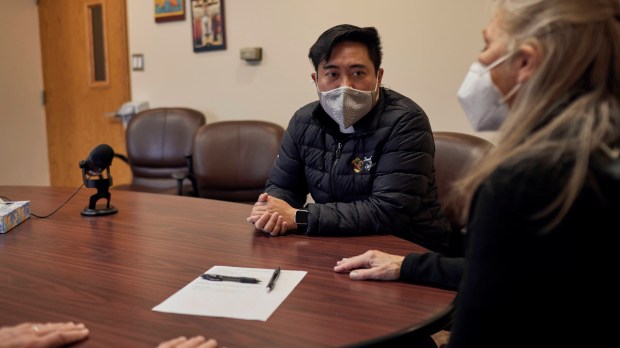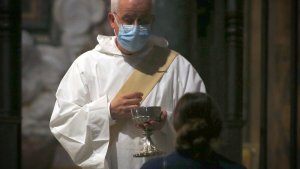If you think about it, a priest and a doctor have similar roles. One cares for physical health and the other for spiritual health, but both are called to a vocation of compassion and healing.
Today, most medical schools use highly realistic medical simulations as a way to train and prepare future doctors. But up until now, priests didn’t get anything comparable in seminary. The closest thing was role playing in their classes.
But these medical simulations inspired a breakthrough in seminarian formation: What if highly realistic simulations could be used to prepare future priests, too?
This is the idea behind a major new initiative at University of St. Mary of the Lake (USML)/Mundelein Seminary. It’s called the Cor Iuxta Meum (“After My Own Heart”) Project: an innovative effort focused on integrating new pedagogical methods into formation programs for seminarians, priests, and lay leaders within the Church.
A key component of the Cor Iuxta Meum Project is developing the simulation-learning methodology. This allows seminarians to practice pastoral encounters in a safe and supportive environment before entering the priesthood. They also receive thoughtful, targeted feedback from faculty observers to refine their approach.
USML/Mundelein Seminary has received a $5,000,000 grant from Lilly Endowment Inc. through its Pathways for Tomorrow Initiative.
These funds will be used to develop a complete simulation laboratory on the USML campus, along with a group of professional simulation actors who will be trained to portray the lives of “standardized parishioners,” each with a fully developed background story specially crafted to meet the goals of the seminary’s learning objectives.
The grant will also fund administrative support for the Seminary Formation Council, which provides training and support to those who serve in diocesan seminary formation, including faculty, advisors and vocation directors.
You can learn more about the Cor Iuxta Meum Project through this YouTube video:
Father John Kartje, rector of USML/Mundelein Seminary, shared with Aleteia how incredibly realistic the simulations are.
“I’ve been a priest for over 20 years, and when I’ve watched these simulations, you couldn’t convince me it wasn’t the same as a real scenario,” he said.
The Cor Iuxta Meum Project is a major investment in Mundelein Seminary. Will the majority of the project focus on the simulation learning approach to training?
While the simulation learning is a significant component of the project, it is only one of several focal points. Others include the development of new pedagogical teaching methods designed to maximally leverage the benefits of the greater emphasis on students’ personal encounters with parishioners.
In addition, we are launching a major collaboration with six of the largest Catholic seminaries in America to develop a series of best practices to help prepare parish pastors and their staffs to partner with the seminaries in the mission of training future priests.
What will simulation learning look like? How will it be implemented? How is it different from what Mundelein is doing now?
While much of the methodology will be similar, major changes consist of the different types of cases that we will be simulating: rather than strictly medical scenarios, we will be creating cases that touch on the broad array of pastoral encounters that parish priests engage with every day (e.g., marital issues, anxiety and depression, spiritual direction, struggles with Church teaching, etc.). In addition, we will be simulating the types of leadership situations that are also common to pastors (e.g., human resource decisions, effectively leading groups, effective collaboration with parish staffs, change management, etc.).
The learning will look like what is portrayed in the video [above], except that we will construct our own simulation lab on the Mundelein campus, with the capacity to reproduce a variety of spaces, from small counseling rooms to large meeting spaces.
While we currently employ small “role play” scenarios within some classes, simulation is much more than role play. It entails an incredibly accurate portrayal of actual scenarios, using professionals to portray the parishioner roles, and providing extensive background research into every case.
In addition, the simulation runs are carefully watched and assessed by several faculty members to provide much more thorough feedback designed to address both the student’s interior experiences as well as his exterior pastoral handling of the situation.
What will the simulation laboratory look like?
We’re building a full simulation lab, a very flexible space, which we’re able to convert in different ways to simulate everything from a confessional or small one-on-one counseling room to a large meeting room where a priest would hold a parish council meeting.
What is the most important thing for others to know about the Cor Iuxta Meum Project?
That it is much more than “role playing”! It is an attempt to realize the vision laid out by St. Pope John Paul II in his seminal document Pastores Dabo Vobis, in which he called for a seminary formation program that is built around the integration of all aspects of the humanity of the seminarian—a large part of which can only be developed via personal encounter between the future priest and the people he will be serving.
Simulation learning is a powerful tool for that endeavor, but it has to be embedded within a much broader approach to overall seminary formation, from the classroom instruction to the onsite parish ministries.



